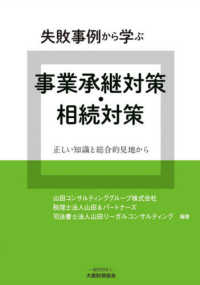- ホーム
- > 洋書
- > 英文書
- > Religion / Ethics
Full Description
In Contentious Unions: Black Baptist Schools and White Baptist Money in the Jim Crow South, Mary Beth Swetnam Mathews interweaves the stories of the founding and development of Richmond Theological Seminary (Virginia), Central City College (Macon, Georgia), and American Baptist Theological Seminary (Nashville, Tennessee)—colleges that saw challenges, complexities, and hard-won accomplishments in the Post-Reconstruction era. Her study begins just after the Civil War, when one of these institutions provided educational opportunities for newly freed slaves, and follows the fortunes of the schools through the 1960s.
Mathews reveals the financial, curricular, and identity struggles of schools that came into being and survived under difficult circumstances. The institutions relied on funding from White Baptists, but also had to fight against control and exploitation from those who helped them financially. Though each school evolved with a different identity and educational mission, Mathews concludes that "they could be simultaneously symbols of racial independence as well as victims of white supremacy."
As "oppositional spaces," these schools gave their communities access to the ground floor of the civil rights movement, and the author highlights their connections to some of the more famous activists such as John R. Lewis, Jo Ann Gibson Robinson, and Gordon P. Hancock. Ultimately, Mathews's book is a fascinating and complex account that uses the history of these three institutions to illuminate the origins of the long struggle for civil rights.


![Get truth太陽の牙ダグラム 〈3〉 - 1/72ソルティックH8ラウンドフェイサーVer. [特装版コミック] ビッグコミックススペシャル (特装版)](../images/goods/ar2/web/imgdata2/40994/4099431398.jpg)
![前田式[味つけ調味料]でおいしい減塩 - 調味料を混ぜるだけ!](../images/goods/ar2/web/imgdata2/45792/4579214331.jpg)




